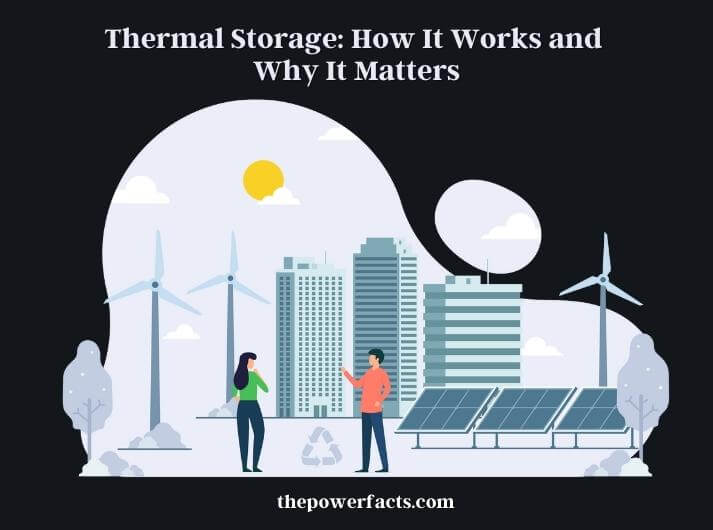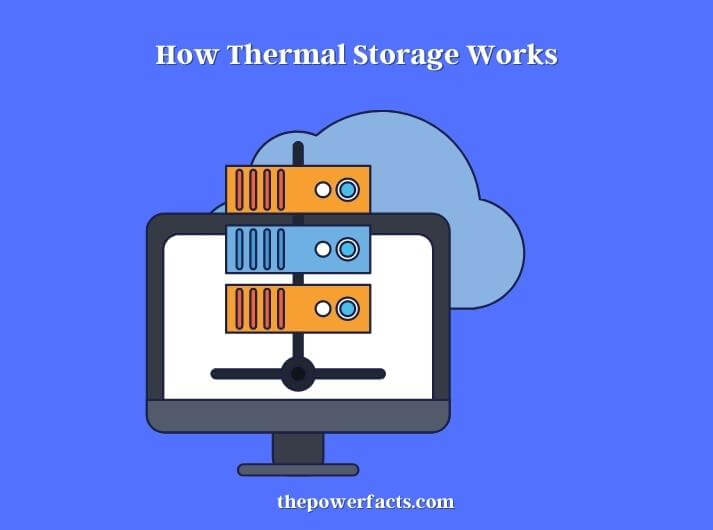Thermal storage is a crucial aspect of energy storage that is becoming increasingly important in today’s world. The demand for energy is growing, and the need for a reliable and sustainable energy system is critical. Thermal storage provides a way to store energy in the form of heat, which can be used to meet demand during peak periods.

In simple terms, thermal storage systems work by storing excess energy produced during off-peak periods and using it during peak periods when demand is high. This process helps to balance the grid and maintain grid stability, particularly in regions where renewable energy sources like wind and solar are becoming increasingly prevalent.
What is Thermal Storage?
Thermal storage refers to the process of storing thermal energy in a medium, such as water, ice, or phase change materials (PCMs), for later use. It is a well-established concept that has been used for centuries in various applications, such as insulation and ice houses.
The process of thermal storage involves capturing and storing excess thermal energy when it is available and using it at a later time when it is needed. This is typically accomplished through the use of a thermal storage system, which can be integrated with other energy systems such as solar thermal collectors or heat pumps.
The choice of storage medium depends on various factors such as the temperature range of the thermal energy, the required storage capacity, and the cost of the materials. Water and ice are commonly used as storage media due to their high thermal capacity, while PCMs are used for their ability to store large amounts of energy in a small volume.
Thermal storage is an important technology for improving energy efficiency and reducing energy consumption, particularly in buildings and industrial processes. It can help to shift energy consumption to off-peak hours, when energy prices are lower, and can also enable the integration of intermittent renewable energy sources into the grid.
Types of Thermal Storage Systems
There are several types of thermal storage systems that are commonly used to store thermal energy for later use. These systems vary in design and operation, depending on the application and the specific requirements of the system.
One type of thermal storage system is the sensible heat storage system. This system stores thermal energy by heating or cooling a storage medium, such as water, rocks, or concrete, to a desired temperature. The stored energy can then be retrieved and used for various applications, such as space heating or cooling.
Another type of thermal storage system is the latent heat storage system. This system stores thermal energy by utilizing phase change materials (PCMs) that undergo a phase change, such as melting or solidifying, at a specific temperature. The energy required for the phase change is stored in the material and can be retrieved and used for heating or cooling applications.
Thermochemical storage systems are another type of thermal storage system. These systems store thermal energy by utilizing reversible chemical reactions that absorb or release energy. These reactions can be used to store and retrieve thermal energy for various applications.
Molten salt storage systems are a type of thermal storage system that utilizes molten salt as the storage medium. Molten salt has a high specific heat capacity and can be heated to high temperatures without boiling or decomposing. These systems are often used in solar thermal power plants to store thermal energy generated during the day for use at night.
Advantages of Thermal Storage
Thermal storage systems offer several advantages that make them a desirable option for various applications. Some of the key advantages of thermal storage include:
Energy Efficiency
Thermal storage systems enable the efficient use of energy by storing excess thermal energy when it is available and using it when it is needed. This helps to reduce energy consumption and can result in significant energy cost savings.
Renewable Energy Integration
Thermal storage systems can help to integrate intermittent renewable energy sources, such as solar and wind power, into the grid. The stored energy can be used during times when the renewable energy source is not available, helping to increase the overall reliability of the system.
Peak Shifting
Thermal storage systems can also be used to shift energy consumption to off-peak hours when energy prices are lower. This can help to reduce energy costs and can also help to alleviate the strain on the grid during peak demand periods.
Reduced Environmental Impact
Thermal storage systems can help to reduce the environmental impact of energy use by enabling the use of renewable energy sources and reducing energy consumption overall.
Improved Comfort
In building applications, thermal storage systems can help to improve comfort by providing a more stable indoor temperature. By utilizing stored thermal energy during periods of high demand, the system can help to maintain a comfortable temperature and reduce the need for additional heating or cooling.
Disadvantages of Thermal Storage
While thermal storage systems offer several advantages, there are also some potential disadvantages that should be considered before implementing a thermal storage system. Some of the key disadvantages of thermal storage include:
Cost: The cost of implementing a thermal storage system can be significant, particularly for systems that require large storage capacities or complex system designs. This can make thermal storage systems less feasible for some applications, particularly in cases where the energy savings may not offset the initial investment.
Space Requirements: Thermal storage systems can require significant space for storage equipment and associated components. This can be challenging in certain applications, particularly in buildings where space may be limited.
Maintenance: Thermal storage systems require ongoing maintenance to ensure optimal performance and address any potential issues that may arise. This can require additional resources and can increase the overall cost of the system.
Storage Medium Limitations: The choice of storage medium for a thermal storage system can be limited by factors such as temperature range, cost, and availability. This can impact the overall effectiveness and feasibility of the system.
Efficiency Losses: Thermal storage systems can experience some efficiency losses due to heat transfer losses, the energy required for system operation, and losses associated with the conversion of thermal energy to other forms of energy.
Thermal Storage Applications
Thermal storage systems are utilized in a wide range of applications, including:
Building HVAC Systems
Thermal storage systems can be used in building HVAC (heating, ventilation, and air conditioning) systems to store thermal energy during off-peak hours and utilize it during peak demand periods. This can help to reduce energy consumption and costs while maintaining a comfortable indoor temperature.
Industrial Processes
Thermal storage systems can be used in various industrial processes to store excess thermal energy and utilize it during periods of high demand. This can help to improve process efficiency and reduce energy costs.
Renewable Energy Integration
Thermal storage systems can be used to store excess energy generated by renewable energy sources, such as solar and wind power, for use during periods when the energy source is not available. This can help to increase the reliability and stability of the grid.
Transportation
Thermal storage systems can be used in refrigerated transportation applications to store thermal energy and maintain a stable temperature during transport. This can help to reduce energy consumption and improve product quality.
Agriculture
Thermal storage systems can be used in agriculture applications to store excess thermal energy and utilize it for greenhouse heating, crop drying, and other processes. This can help to improve efficiency and reduce energy costs.
Thermal Storage Technologies
There are various thermal storage technologies that are used to store thermal energy for later use. Some of the key thermal storage technologies include:
Sensible Heat Storage
Sensible heat storage involves storing thermal energy in a material by raising its temperature. This can be done using a variety of materials, such as water, concrete, or gravel. The stored energy can then be used for heating or cooling applications.
Latent Heat Storage
Latent heat storage involves storing thermal energy by changing the phase of a material, such as from solid to liquid or liquid to gas. This can be done using materials such as phase change materials (PCMs) or even ice. The stored energy can then be used for heating or cooling applications.
Thermochemical Storage
Thermochemical storage involves storing thermal energy by using chemical reactions to store and release energy. This can be done using a variety of materials, such as metal hydrides, which can absorb and release hydrogen gas to store and release thermal energy.
Adiabatic Compressed Air Energy Storage (CAES)
Adiabatic CAES involves storing thermal energy by compressing air and storing it in an insulated container. The stored energy can then be released by expanding the air and using it to generate electricity.
Pumped Thermal Energy Storage (PTES)
PTES involves storing thermal energy by pumping hot or cold fluids between two storage tanks at different temperatures. The stored energy can then be used for heating or cooling applications or to generate electricity.
Implementing Thermal Storage
When implementing a thermal storage system, it is important to carefully consider a range of factors to ensure optimal performance and cost-effectiveness. Some key considerations for implementing a thermal storage system include:
Energy Demand Profile
Understanding the energy demand profile is critical to designing an effective thermal storage system. This involves analyzing energy usage patterns to determine when and how energy is consumed and identifying opportunities for energy storage and utilization.
Storage Capacity
The storage capacity of a thermal storage system will depend on the energy demand profile and the specific application. The capacity should be sufficient to meet peak demand periods while maintaining energy efficiency and cost-effectiveness.
Storage Medium
The choice of storage medium will depend on factors such as temperature range, cost, and availability. It is important to select a storage medium that is appropriate for the intended application and that provides optimal performance and cost-effectiveness.
System Design
The design of a thermal storage system will depend on factors such as the storage medium, the energy demand profile, and the specific application. It is important to work with experienced engineers and designers to ensure that the system is designed for optimal performance and efficiency.
Maintenance
Ongoing maintenance is critical to ensuring a thermal storage system’s optimal performance and longevity. This includes regular inspections, cleaning, and repair as needed.
How Thermal Storage Works?
Thermal storage works by storing excess thermal energy for later use when needed. The process typically involves converting thermal energy into a different form, such as storing it as sensible heat or latent heat, or through thermochemical reactions. The stored thermal energy can then be used to meet heating or cooling demands or generate electricity.

In a sensible heat storage system, thermal energy is stored by raising the temperature of a material, such as water or concrete, using an external heat source. The stored energy can then be released later by transferring the heat to a space or fluid that needs heating.
In a latent heat storage system, thermal energy is stored by changing the phase of a material, such as from solid to liquid or liquid to gas, using a phase change material (PCM). During the charging process, the PCM absorbs thermal energy, causing it to melt or vaporize. During the discharging process, the PCM releases thermal energy by solidifying or condensing.
In a thermochemical storage system, thermal energy is stored through chemical reactions that absorb or release energy. For example, metal hydrides can be used to store and release hydrogen gas, which can be used to generate thermal energy.
Thermal storage systems can be used in a range of applications, such as building HVAC systems, industrial processes, and renewable energy integration. By storing excess thermal energy and releasing it when needed, these systems can help to improve energy efficiency, reduce costs, and increase the reliability of energy systems.